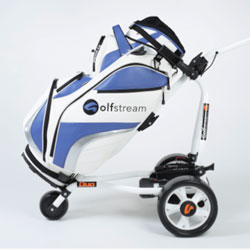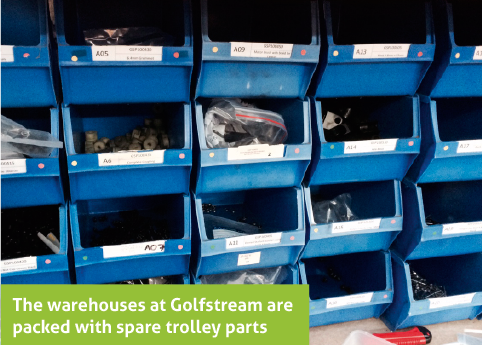
Derek Richford, joint owner of Golfstream, has been in the golf trolley business for approaching two decades. He sat down with Andy Brown to talk about how the industry has changed, fixing trolleys and why this sector may have reached the peak of its technological innovation.
It would be quite easy to get lost in the offices of Golfstream – the company have several warehouses filled with people fixing machines, doing various bits of tinkering and housing more spare golf trolley parts than you could ever wish to see. If you need a part for an obscure trolley that a customer bought five years ago it would be no surprise to learn that, buried deep on a shelf somewhere, Golfstream have the part you need.
 Richford first entered the golf trolley market when he joined PowaKaddy in 1998. He stayed there for eleven years, looking after so many different areas that he jokes that he has a room at his home filled with all the different business cards he amassed in his time there. Despite this self-deprecation, Richford held many important roles in the company but when it was sold and production moved to China he left to set up Golfstream. The new company made a British based trolley but this didn’t prove to have the impact that he hoped. “We thought that to be British-made would be the panacea and everyone would want to buy from us but that was quite naïve,” he recalls. “Although people said they wanted to buy British, when you sent them your product and it was the same price as others they wouldn’t always go with you.”
Richford first entered the golf trolley market when he joined PowaKaddy in 1998. He stayed there for eleven years, looking after so many different areas that he jokes that he has a room at his home filled with all the different business cards he amassed in his time there. Despite this self-deprecation, Richford held many important roles in the company but when it was sold and production moved to China he left to set up Golfstream. The new company made a British based trolley but this didn’t prove to have the impact that he hoped. “We thought that to be British-made would be the panacea and everyone would want to buy from us but that was quite naïve,” he recalls. “Although people said they wanted to buy British, when you sent them your product and it was the same price as others they wouldn’t always go with you.”
The company still successfully make trolleys to this day, but Richford soon discovered a gap in the market that he exploited: spare parts. “We realised that people were actually being charged a lot for spare parts or they couldn’t even get hold of them. We managed to get hold of a great raft of spare parts and suddenly people were coming to us in droves from around the world and buying thousands of pounds worth of spares that they couldn’t find anymore,” he says.
“We built up a good reputation on having the product and the knowledge of what they needed and the answers to all of their questions. Our business this year will turn over not far from £2m from selling spare parts, batteries, chargers and some trolleys. If you have anything over five or six years old we are often the only place where you can get spares.”
 The golf trolley market has changed rapidly over the last decade – they are now seen by the customer as a desirable product rather than only something for the older generation – and while the spare parts market isn’t as sexy as some of the new products that various companies are producing, it is a vital one. For a pro to be able to tell their members that they don’t have to continue to fight a running battle with their trolley with a wonky wheel or temperamental electrics has to be beneficial.
The golf trolley market has changed rapidly over the last decade – they are now seen by the customer as a desirable product rather than only something for the older generation – and while the spare parts market isn’t as sexy as some of the new products that various companies are producing, it is a vital one. For a pro to be able to tell their members that they don’t have to continue to fight a running battle with their trolley with a wonky wheel or temperamental electrics has to be beneficial.
“Most trolleys we can repair and there are some trolleys that we are the only people that can repair them,” says Richford. “We fix things in-house. It’s all about the questions that you ask: ‘If you plug in the battery do you have lights?’ ‘Have you tried your trolley on a different battery?’ Once you have gone through the questioning you have a good idea what it’s going to be.”
If you are a pro who fancies themselves as being handy with a screwdriver then Richford says they have been known to talk to pros on the phone while they try and fix the trolley themselves, otherwise the company offer a delivery and collection service. “For a flat fee of £25 including VAT we will pick up from your golf club, bring it back here, find out what is wrong with it, quote you and then deliver it back.”
Richford estimates that around 85 per cent of the company’s business is through golf pros and clearly takes the firm’s customer service seriously. He talks passionately about doing things the ‘old fashioned’ way and providing a good service. He says that he appreciates that golf trolleys don’t always offer the same margin as other items, but argues that they can actually be more profitable. “The thing to remember is that 30 per cent on a bar of chocolate will only earn you a few pence, whereas 25 per cent from a golf trolley might get you around £70, so there has to perhaps be a change in mentality. In the main, golf retailers are very good golfers but they didn’t get to the position they are in because they happen to be good retailers.”
As this article has already touched on golf trolleys, arguably more than any other area of the industry, have experienced a massive change over the last decade. They are now good-looking and desirable, and it is not a surprise to see a young golfer with an electric trolley. When I speak to Richford about this he uses a slightly strange analogy – he compares electric trolleys to dishwashers.
“Initially golf trolleys were something you looked at and thought, ‘I might need one of those one day when I am older’ but there was a switch, probably from around 2005-08 where the electric golf trolley has now become a desirable and good-looking product. It’s a bit like a dishwasher – once you’ve had it, you’ll never go back,” he says.
 “Certainly from the 15th hole, it doesn’t matter how strong you are, if you have been carrying your clubs then your swing will not be as good and neither will your power. You would pay £300 for a top driver which you hope might knock a stroke off, but you can have a powered golf trolley for similar money which is potentially going to knock a couple of strokes off and stop you having long-term back problems.”
“Certainly from the 15th hole, it doesn’t matter how strong you are, if you have been carrying your clubs then your swing will not be as good and neither will your power. You would pay £300 for a top driver which you hope might knock a stroke off, but you can have a powered golf trolley for similar money which is potentially going to knock a couple of strokes off and stop you having long-term back problems.”
One of the company’s most successful facets is a brand called Caddy Cell, which makes batteries for trolleys. From February 2016 they will be producing a battery with a USB port on it, something that Richford hopes will broaden the appeal of the product. “A lot of people might think you don’t need one, and you shouldn’t be charging your phone or GPS on the golf course, but it is not really for this. However, what it does mean is that it will be really interesting for fishermen, people that go camping or to festivals, because one of the key things if that we are all using our smart phones and tablets more and they are always running out of power. You shouldn’t look at golfers as that being all they do; they will also go camping or fishing. If they buy our product from around February 2016 it means they will be able to charge their phones or tablets and the battery will be enough to keep three iPads going for a week, so it has an added value.”
Richford may hope that the product plays a role in the future success of his company, but what about the wider golf trolley market? The area has seen such change in the last decade – will the next 10 years bring about such change that trolleys will be vastly different to what we see today? The owner of Golfstream thinks not. “On the technology front there will be different materials used, such as a carbon fibre machine that is coming through, but on the electronics, our customers are saying to us that things are getting too complicated,” he says. “One of the key things that we do is have a ‘simplicity mode’ so if you get someone that wants it be to easier we can program it in 30 seconds so that it just has faster, slower, on and off. More and more people are asking for this. I think we’ve gone through to the top of what technology is offering and I don’t think people want any more.”
Whatever the future holds, whether the technology employed by golf trolley manufacturers continues to increase or is scaled back, the positive way that golf trolleys are now viewed by consumers won’t alter. With increasing numbers of golfers purchasing powered trolleys this is certainly an area where the golf pro who is clued up on this sector and its latest developments could well reap the rewards.








